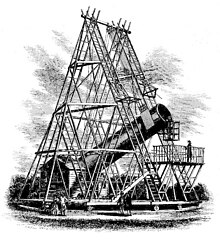40-foot telescope
 |
|
| Alternative names | Great Forty-Foot telescope |
|---|---|
| Location(s) |
Slough |
| Coordinates | 51°30′30″N 0°35′43″W / 51.5082°N 0.5954°WCoordinates: 51°30′30″N 0°35′43″W / 51.5082°N 0.5954°W |
| Built | 1785–1789 |
| First light | 19 February 1787 |
| Decommissioned | 1840 |
| Telescope style |
reflecting telescope, Altazimuth mount |
| Diameter | 48 in (1.2 m) |
| Focal length | 12 m (39 ft) |
|
|
|
|
[]
|
|
William Herschel's 40-foot telescope, also known as the Great Forty-Foot telescope, was a reflecting telescope constructed between 1785 and 1789 at Observatory House in Slough, England. It used a 120-centimetre (47 in) diameter primary mirror with a 12-metre-long (1,200 cm) focal length (hence its name "Forty-Foot"). It was the largest telescope in the world for 50 years. It may have been used to discover Enceladus and Mimas, the 6th and 7th moons of Saturn. It was dismantled in 1840; today the original mirror and a 10-foot (3.0 m) section of the tube remain.
The telescope was constructed by Sir William Herschel, with the assistance of his sister Caroline Herschel, between 1785 and 1789 in Slough, with components made in Clay Hall near Windsor. The 40 ft (12 m) tube was made of iron. The telescope was mounted on a fully rotatable alt-azimuth mount. It was paid for by King George III, who granted £4,000 for it to be made. During construction, whilst the telescope tube lay on the ground, the King as well as the Archbishop of Canterbury visited the telescope. Just prior to them entering the open mouth of the tube, the King commented "Come, my Lord Bishop, I will show you the way to Heaven!"
Two 48-inch (120 cm) concave metal mirrors were made for the telescope, each with a focal ratio of f/10. The first was cast in a London foundry on 31 October 1785, and was made of speculum (an alloy of mostly copper and tin) with arsenic to improve the finish. It weighed 1023 lb after being cast, but it was found to be 0.9 inches thinner at the centre than at the edge (where it was around 2 inches thick). Over a year was spent grinding and polishing the mirror; however, Herschel found it to be "much too thin to keep its figure when put into the telescope" (despite weighing half a ton). A second mirror with twice the thickness of the original was cast a few years later, and this was used rather than the original. However, this required more frequent polishing due to the fast tarnishing nature of the metal, and the original mirror was used when the second was being polished. The mirrors remained the largest in the world until 1845.
...
Wikipedia

